Amputees ready for Baja 1000
HERO Racing team's adaptive riders enter legendary off-road race for charity
By Tes Sewell | ESPN.com
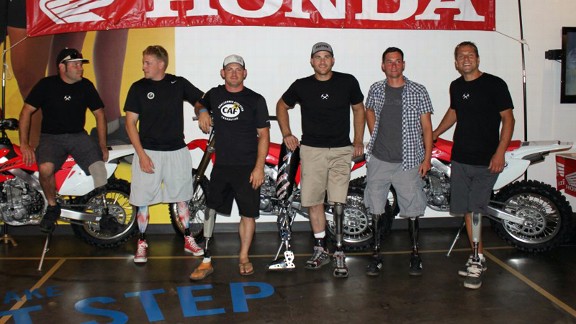 Courtesy of HERO RacingThe HERO Racing team gets ready to hit the start line at the Baja 1000 off-road race.
Courtesy of HERO RacingThe HERO Racing team gets ready to hit the start line at the Baja 1000 off-road race.
Each November, the best in off-road racing gather in Northern Mexico for the legendary Baja 1000. As its name would suggest, this is a 1,000-mile dirt race down the Baja Peninsula. It is beyond any doubt one of the toughest races in the world.
This year, a team of three amputees is going to attempt the race on Honda CRF450x race bikes Thursday to Saturday. Jim Wazny, Chris Ridgway and Mario Panagiotopoulis all have different stories of how they came to lose their limbs, but are all united in one common cause this month.
With Support from M&M Racing, Johnny Campbell Racing, Fox Shox and FMF exhausts they are all decked out and ready to hit the start line. I talked to Paul Thomas the manager of their HERO Racing team to get a little insight into this incredible quest.
ESPN.com: One thousand miles off road. Why on Earth would these guys put themselves through something like this?
Thomas: The reason why we are doing this is that HERO Racing stands for "Helping Everyone Reach Out" so the mission of the HERO Racing team is for everybody to go and be a part of a cause-related event outside of just doing the race for the sake of racing.
Thomas: The reason why we are doing this is that HERO Racing stands for "Helping Everyone Reach Out" so the mission of the HERO Racing team is for everybody to go and be a part of a cause-related event outside of just doing the race for the sake of racing.
We are combining racing with the charitable endeavor. That's why the guys are involved in the race because even though they are proving to the world what amputees can do and that anyone can do it if they set their mind to it, we are partnered with the Challenged Athletes Foundation and we basically got a new leg for a boy who needed it. We did not know who the boy was going to be since the Challenged Athletes Foundation has a lot of requests for limbs. There is a big application process that people go through and then a selection process to see who is going to get what.
This boy, Nicholas Knotts, is the recipient of the leg. We got an amazing video from Nicholas and his dad thanking the HERO Racing team and saying how it is going to change his life. That's why these guys did it, it wasn't to go out there and joyride or just to show what amputees can do -- that was only a small part of it.
[+] Enlarge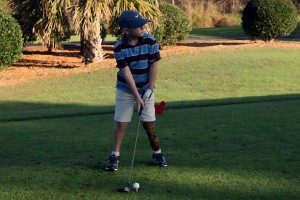

Courtesy of HERO RacingThe HERO Racing team partnered with the Challenged Athletes Foundation to give Nicholas Knotts a new leg.
How big is this team?
There are about 40 people on our race team with support and chase trucks. There are a lot more than just the amputee riders. It's about everybody coming together to go and raise money and to help people out that are in tough situations.
There are about 40 people on our race team with support and chase trucks. There are a lot more than just the amputee riders. It's about everybody coming together to go and raise money and to help people out that are in tough situations.
So you have a three-man team that has to race 1,000 miles. Have any of these guys actually done anything like this?
Mario has raced it in a buggy and Chris Ridgway has raced it a few times on a motorcycle and actually raced the Baja 2000 one year when they had it. [In that race] one of his riders dropped and he had to race over 900 miles on his own. So he's pretty studly.
Mario has raced it in a buggy and Chris Ridgway has raced it a few times on a motorcycle and actually raced the Baja 2000 one year when they had it. [In that race] one of his riders dropped and he had to race over 900 miles on his own. So he's pretty studly.
You know, with these guys, if you look at their backgrounds, they are pretty tested athletes. Chris used to race Supercross, he has won more X Games adaptive gold medals on the bike than anybody and Jim has always been kind of the bridesmaid. If it wasn't Chris winning it was Mike Schultz winning and Jim would come in second [laughs]. This is really big for all the guys.
So as part of this race they are actually going to carry that prosthetic all of the way from the start to the finish?
Yes.
Yes.
Wow, so as if this race was not hard enough, they decided to take that extra burden on?
Yeah, and they are capable of posting a good time, but no one is going to jinx themselves and predict their finish time for the 1000 because that's a sure-fire way to screw yourself.
Yeah, and they are capable of posting a good time, but no one is going to jinx themselves and predict their finish time for the 1000 because that's a sure-fire way to screw yourself.
[+] Enlarge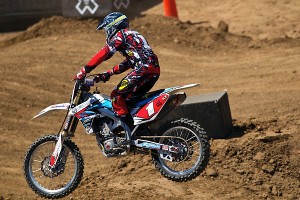

Chris Tedesco/ESPN Action SportsChris Ridgway won X Games gold in Moto X Super X Adaptive in 2009 and was first in 2008 when it was a demonstration.
You're talking about 30 percent of all vehicles that start the 1000 -- that's about 400 vehicles -- only about 30 percent of them complete the race. That includes the Robby Gordons and the Johnny Campbells. Guys spend a lot of money to race the 1000 and they still break down, still have accidents, still get injured.
When only three out of every 10 vehicles cross the finish line, you are pretty stoked when you do. So we are not going to go out there and try to set any speed records. Safety is our main concern because the race really has two starts. First you have the actual start of the race and we are very lucky because SCORE [the race organizer] has a lottery to pull starting positions and they actually pulled us first out of the lottery to start first overall. So Chris Ridgway is first off the line for the entire race.
Wow, the very first rider?
The very first rider of any class. He's like leading the Baja 1000! He was drawn randomly and we are pretty stoked with that.
The very first rider of any class. He's like leading the Baja 1000! He was drawn randomly and we are pretty stoked with that.
So you have the actual start of the race, which is just mayhem, and between Ensenada and San Felipe with Mexicali, Tecate and Tijuana, you probably have the majority of people that live in Baja California. They come en masse to watch the race and most of the booby traps [because unfortunately people like to booby trap the course], that's where they are.
You're dodging dogs and cows and people and all this crap so that first 150 miles is really sketchy. Did you ever see pictures of the Tour de France where the people come out and they try to slap the riders on the back and take pictures?
[+] Enlarge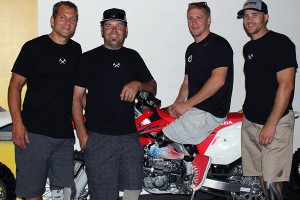

Courtesy of HERO RacingMembers of the HERO Racing team will start racing Thursday in the Baja 1000.
Oh, yeah.
Well, they do the same thing for this race, except trophy trucks are coming at them at 140 [mph]! They're just nuts and it's dangerous, but if you can get through that section you have probably already lost a good 20 percent of the field. Then the next race starts -- and what people consider is the real start of the race -- that's the nighttime.
Well, they do the same thing for this race, except trophy trucks are coming at them at 140 [mph]! They're just nuts and it's dangerous, but if you can get through that section you have probably already lost a good 20 percent of the field. Then the next race starts -- and what people consider is the real start of the race -- that's the nighttime.
Night is gnarly because you have limited visibility. You have dust, you have fog and on a bike you have to worry about trophy trucks because from the dust others leave behind they can't really see you. You could be killed. People die at the Baja all of the time.
Bikes are on the same course as all the trucks and all the buggies and everything else, right?
That's what makes the Baja unique. You will never race the Indy 500 against Mario Andretti or race NASCAR against Jimmie Johnson, but in Baja you can race against Robby Gordon and the top people in off-road at the same time. You could have a stock $10,000 VW Bug on the course at the same time as a million-dollar trophy truck. Anybody can enter, but not anybody can enter the Indy 500 or the Daytona 500.
That's what makes the Baja unique. You will never race the Indy 500 against Mario Andretti or race NASCAR against Jimmie Johnson, but in Baja you can race against Robby Gordon and the top people in off-road at the same time. You could have a stock $10,000 VW Bug on the course at the same time as a million-dollar trophy truck. Anybody can enter, but not anybody can enter the Indy 500 or the Daytona 500.
That's true.
Our guys that are amputees, they have other concerns too. We put reflective tape on their prosthetics because if they happen to crash at nighttime and their leg goes flying off -- they have to find out where the heck that thing is. At night time, in the dark and it's pitch black!
Our guys that are amputees, they have other concerns too. We put reflective tape on their prosthetics because if they happen to crash at nighttime and their leg goes flying off -- they have to find out where the heck that thing is. At night time, in the dark and it's pitch black!
We have three bikes. We have the amputee bike and we have a bike [team] in front of them that is racing and a bike behind them. I'm actually on the bike behind them with my five guys. Our goal is to make sure they are OK.
What are the racing categories that the bikes are in?
We have two bikes in Class 22, which is the Open Pro and then we have one bike in the 40 class, which are the 40-year-olds. They have some of our fastest riders right there, so they will be leading the way.
We have two bikes in Class 22, which is the Open Pro and then we have one bike in the 40 class, which are the 40-year-olds. They have some of our fastest riders right there, so they will be leading the way.
[+] Enlarge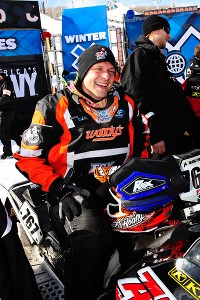

Mike Roth/Shazamm/ESPN ImagesJim Wazny was third in Adaptive SnoCross at Winter X Games in 2011 and second in 2010.
We have younger guys as well and they can't race in the 40 class. My team is mixed ages so we have to race in the Open Pro, even though we are not trying to compete against the top riders in the world, that's just the class we fall into.
So what other safety components does the team have in place? I imagine the guys are using special riding prosthetics, which are probably not too good for walking around the desert. What happens when it goes wrong?
If bikes break you wear your tool packs. Everybody out there knows how to fix flats and do a tire and a wheel change. But if you break a limb or your bike breaks or your engine seizes you're done, and that's just the way it is.
If bikes break you wear your tool packs. Everybody out there knows how to fix flats and do a tire and a wheel change. But if you break a limb or your bike breaks or your engine seizes you're done, and that's just the way it is.
It's serious s--- to enter the Baja 1000 and to take that challenge on to show what guys who are missing a part can do -- that's pretty impressive. I can't tell you all the emails and Facebook hits we are getting from kids and adults all over the world who say they are sending their prayers, or they're fans, or sending us pictures of their kids who were born without legs and saying, "we're pulling for you guys. It's so inspirational and motivational."
That's in addition to these guys racing to provide a leg for Nicholas. Ossur and Wright/Filippis, they are the prosthetic company who donated the leg. This story is two-fold: The guys want to show what they can do, but most importantly, they are doing it for Nicholas. We've got a mission. In our eyes we fail if we don't cross the finish line.
Check out the team's progress at Julian Hard Cider HERO Racing on Facebook or atjhcheroracing.com.
 AP Photo/Guillermo AriasFans catch the action, and a nap, on the route of the Baja 1000 in Baja, Mexico.
AP Photo/Guillermo AriasFans catch the action, and a nap, on the route of the Baja 1000 in Baja, Mexico.
No comments:
Post a Comment